Is Sushi Keto Friendly? A Clear Answer to Your Question
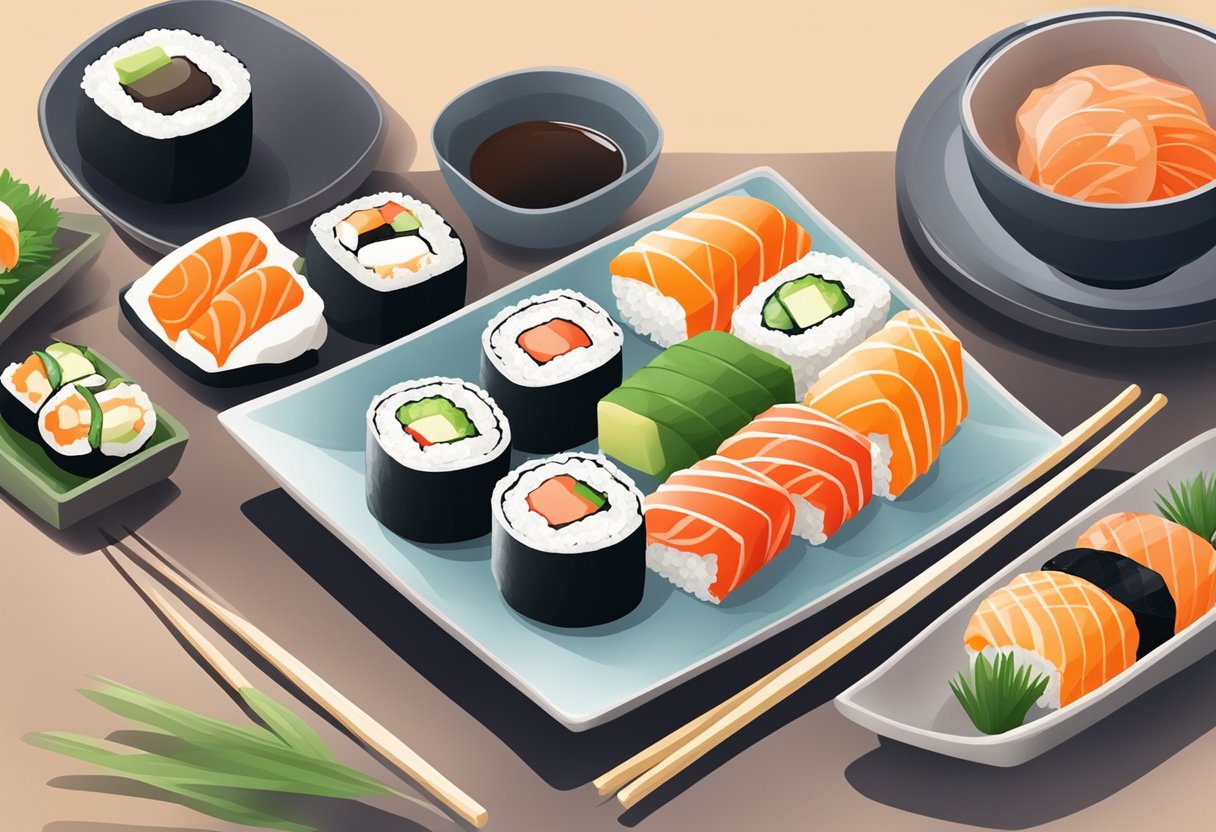
Sushi has become a popular choice for many people who enjoy Japanese cuisine. However, for those who follow a keto diet, the question arises, “Is sushi keto-friendly?” The answer is not straightforward, as it depends on the type of sushi and the ingredients used.
Sushi typically consists of rice, fish, and vegetables, which are all low in carbohydrates. However, the rice used in sushi is high in carbs, making it unsuitable for a keto diet. The good news is that some sushi restaurants offer keto-friendly options, such as sushi rolls made with cauliflower rice or wrapped in cucumber instead of rice.
It’s important to note that not all sushi rolls are created equal, and some may contain high-carb ingredients like tempura or sweet sauces. Therefore, it’s essential to read the menu carefully and ask the server about the ingredients before ordering. In summary, while sushi can be a healthy and delicious option, those following a keto diet should be mindful of the rice and other high-carb ingredients and opt for keto-friendly alternatives when possible.
Understanding Keto Diet
The ketogenic diet, or keto diet, is a low-carb, high-fat diet that has been shown to help people lose weight. The goal of the diet is to put the body into a state of ketosis, where it burns fat for fuel instead of carbohydrates.
To achieve this, the keto diet limits carbohydrates to a very low amount, typically 20-50 grams per day. This means that foods like bread, pasta, and rice are off-limits, as they are high in carbs.
Instead, the diet emphasizes high-fat foods like meat, cheese, and butter, as well as low-carb vegetables like leafy greens and cauliflower. The idea is to get most of your calories from fat, with a moderate amount of protein and very few carbs.
One key concept in the keto diet is net carbs. This is the total number of carbohydrates in a food minus the fiber and sugar alcohols. Since fiber and sugar alcohols don’t affect blood sugar levels, they are subtracted from the total carbs to give the net carbs.
For example, a cup of broccoli has 6 grams of total carbs, but 2 grams of fiber. This means it has 4 grams of net carbs. On the keto diet, it’s important to focus on net carbs rather than total carbs.
Overall, the keto diet can be an effective way to lose weight and improve health markers like blood sugar and cholesterol levels. However, it’s important to consult with a healthcare professional before starting the diet, as it can be difficult to follow and may not be appropriate for everyone.
What is Sushi
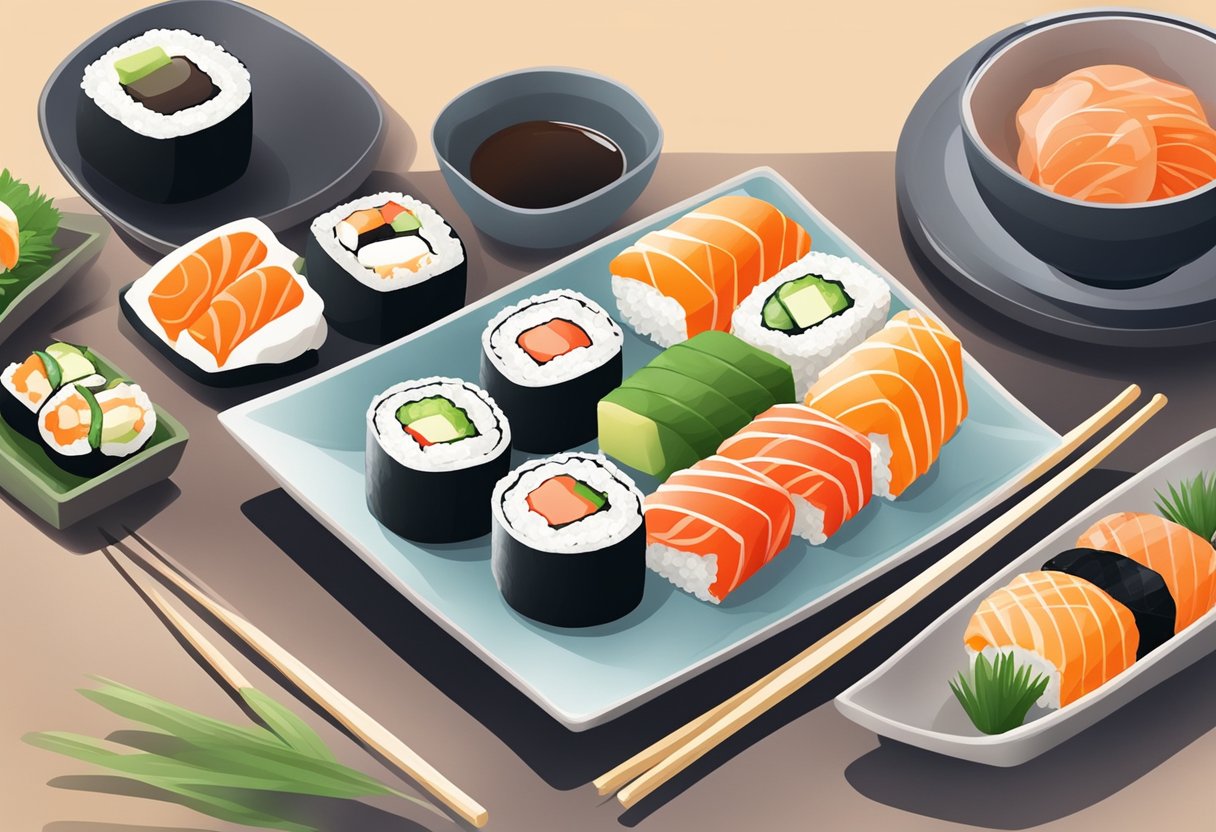
Sushi is a traditional Japanese dish that consists of vinegared rice, combined with various ingredients such as seafood, vegetables, and sometimes fruits. The dish is often served with soy sauce, wasabi, and pickled ginger.
The main component of sushi is the rice, which is cooked with vinegar, sugar, and salt to give it a distinct flavor. The rice is then rolled into various shapes, such as rolls, cones, or balls, depending on the type of sushi being prepared.
Nori, a type of seaweed, is often used to wrap the sushi, giving it a distinctive flavor and texture. Sushi rolls, also known as maki, are the most common type of sushi and are typically filled with a combination of rice, fish, and vegetables.
Nigiri is another popular type of sushi, consisting of a small ball of rice topped with a slice of raw fish or other seafood. Temaki, or hand rolls, are cone-shaped sushi rolls that are typically filled with rice, fish, and vegetables.
Overall, sushi is a versatile dish that can be enjoyed in many different forms and flavor combinations. While rice is a primary ingredient in sushi, there are also low-carb options available for those following a keto diet.
Carbs in Sushi
Sushi is a popular Japanese dish that consists of small portions of raw or cooked fish, vegetables, and rice. It is a low-fat and low-calorie food that is often considered healthy. However, when it comes to the keto diet, the carb content of sushi needs to be taken into account.
The main source of carbs in sushi is the sushi rice. Sushi rice is a short-grain rice that is cooked with vinegar, sugar, and salt. The sugar and vinegar in the rice add to the carb content. A typical serving of sushi rice contains around 45 grams of carbs.
Other ingredients in sushi can also contribute to the carb count. For example, some sushi rolls contain avocado, which is a high-fat and low-carb food. However, a half of an avocado contains around 9 grams of carbs. Additionally, some sushi rolls contain tempura, which is a deep-fried batter that is high in carbs.
It is important to note that not all sushi rolls are created equal in terms of carb content. For example, a basic tuna roll contains only around 1 gram of carbs, while a California roll can contain up to 30 grams of carbs due to the addition of crab and avocado.
Overall, sushi can be keto-friendly if you choose the right rolls and avoid those that contain high-carb ingredients like sushi rice and tempura. It is important to read the menu carefully and ask your server about the ingredients if you are unsure.
Sushi Ingredients and Their Keto Compatibility
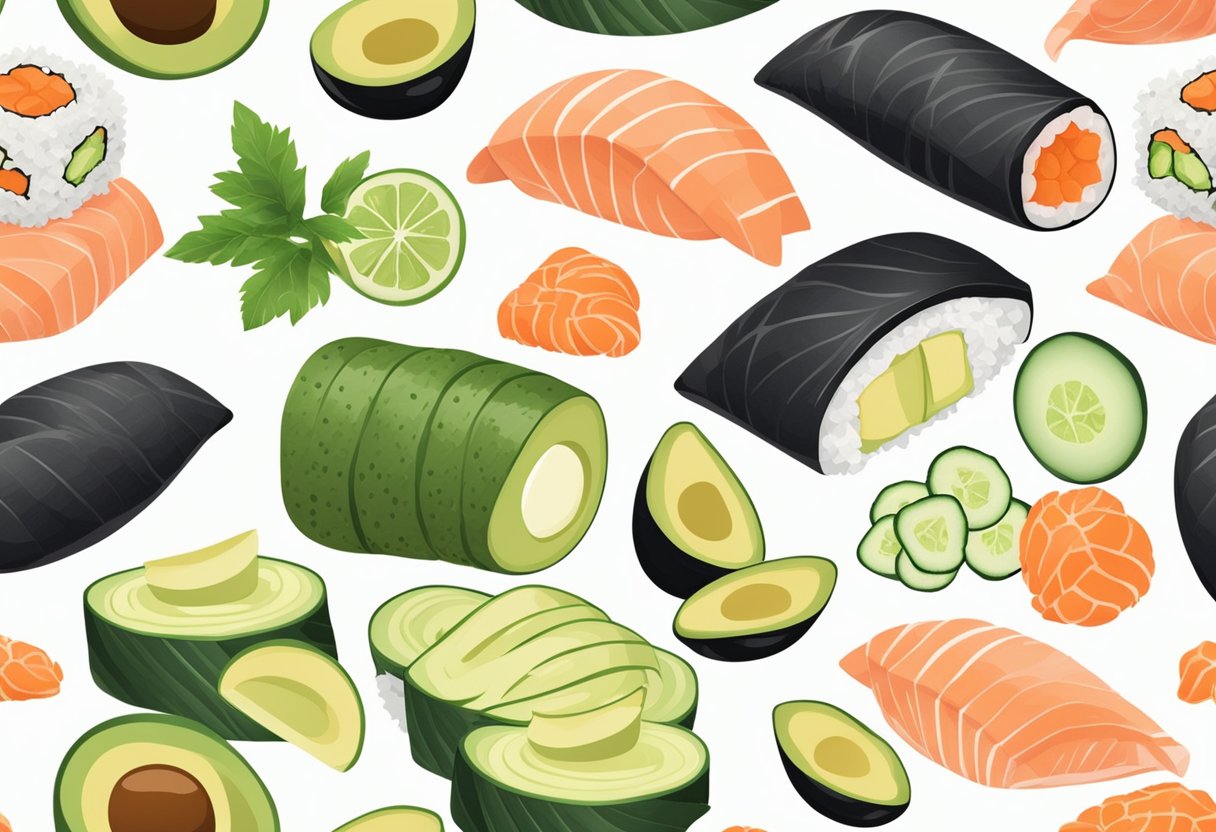
When following a keto diet, it’s important to be mindful of the ingredients in sushi, as many traditional sushi rolls contain rice, which is high in carbs. However, there are still plenty of keto-friendly sushi options that can satisfy your cravings.
Fish in Sushi
Fish is a staple ingredient in sushi and is generally keto-friendly. Popular fish options like salmon, tuna, yellowtail, and snapper are all great choices. Sashimi, which is thinly sliced raw fish, is also a great option. However, it’s important to avoid any fish that is breaded or served with a sugary sauce.
Vegetables in Sushi
Vegetables are another important ingredient in sushi, but not all vegetables are keto-friendly. Cucumber and avocado are great options, as they are low in carbs. Other vegetables commonly used in sushi, such as carrots and bell peppers, should be eaten in moderation due to their higher carb content.
Other Sushi Ingredients
Some other common sushi ingredients that may or may not be keto-friendly include:
- Shellfish: Shrimp, crab, and other shellfish are generally keto-friendly, but be cautious of any sauces they may be served with.
- Seaweed: Seaweed is a great source of nutrients and is low in carbs, making it a great addition to any sushi roll.
- Imitation crab: Often made with fillers like wheat and sugar, imitation crab should be avoided on a keto diet.
- Sauces: Many sushi rolls are served with sauces like mayo, teriyaki, and sriracha, which can be high in carbs. It’s best to ask for these sauces on the side or avoid them altogether.
- Tempura: Avoid any sushi rolls that are fried in tempura batter, as it is high in carbs.
- Ginger: Pickled ginger is a great palate cleanser and is low in carbs.
- Soy sauce: While soy sauce is low in carbs, it is high in sodium, so it should be used in moderation.
- Nori sheets: These thin sheets of seaweed are used to wrap sushi rolls and are low in carbs.
- Mushrooms: Mushrooms are a great addition to any sushi roll and are low in carbs.
- Paprika: Paprika is often used as a garnish and is low in carbs.
Overall, there are plenty of keto-friendly sushi options available. By choosing ingredients carefully and avoiding high-carb options like rice and tempura, you can enjoy sushi while sticking to your keto diet.
Keto Friendly Sushi Options
Sushi is a popular Japanese dish that is loved by many, but is it keto-friendly? The answer is yes, but it depends on what you order. Here are some keto-friendly sushi options to consider:
- Sushi without rice: Opt for sushi rolls without rice, such as naruto rolls, which are made with cucumber instead of rice. These rolls are low in carbs and high in fiber, making them a great option for those following a keto diet.
- Real crab: Some sushi rolls are made with imitation crab, which is often made with fillers and added sugars. Instead, choose sushi rolls made with real crab meat, such as the Alaska roll, which is made with salmon, avocado, and real crab meat.
- California roll: The California roll is a popular sushi roll that is made with crab, avocado, and cucumber. It is a great option for those following a keto diet, as it is low in carbs and high in healthy fats.
- Philadelphia roll: The Philadelphia roll is made with salmon, cream cheese, and cucumber. It is a delicious and keto-friendly option that is high in protein and healthy fats.
- Rainbow roll: The rainbow roll is made with a variety of fish, such as salmon, tuna, and yellowtail. It is a great option for those following a keto diet, as it is high in protein and healthy fats.
Overall, sushi can be a great option for those following a keto diet, as long as you choose the right options. Opt for sushi rolls without rice, real crab meat, and rolls that are high in protein and healthy fats.
Sushi and Keto Diet: Health Benefits and Considerations
Sushi is a popular Japanese dish that consists of vinegared rice, seafood, and vegetables. It is a low-calorie, high-protein food that can be a great addition to a keto diet. However, there are a few things to consider when it comes to sushi and keto.
Protein and Calories
Sushi is a great source of protein, which is essential for building and repairing muscles. However, it can also be high in calories, especially if it contains fried ingredients or is served with a lot of rice. To keep the calories in check, it’s best to choose sushi that is low in fat and calories, such as sashimi or sushi rolls made with vegetables and lean protein.
Cream Cheese and Shrimp
Some sushi rolls contain cream cheese, which is high in fat and calories. While cream cheese can be a tasty addition to sushi, it’s best to avoid it on a keto diet. Instead, opt for sushi rolls that contain shrimp, which is low in calories and high in protein.
Cauliflower Rice and Sushi Rice
Sushi rice is made with vinegar and sugar, which can be high in carbs. To make sushi keto-friendly, some restaurants offer cauliflower rice as a substitute. Cauliflower rice is low in carbs and high in fiber, making it a great option for those on a keto diet.
Health Benefits
Sushi can provide a variety of health benefits, including omega-3 fatty acids from fish, antioxidants from vegetables, and fiber from seaweed. However, it’s important to choose sushi that is fresh and made with high-quality ingredients to maximize its health benefits.
Cooked Crab and Vegan Options
Cooked crab is a great option for those who don’t like raw fish. It’s low in calories and high in protein, making it a great addition to a keto diet. For those who follow a vegan diet, there are also options such as vegetable rolls or rolls made with tofu.
Gluten-Free and Fiber
Sushi can be a great option for those who follow a gluten-free diet, as long as the soy sauce is also gluten-free. Seaweed used in sushi is also a great source of fiber, which can help promote digestive health.
In conclusion, sushi can be a great addition to a keto diet, as long as it’s made with high-quality ingredients and low in calories and carbs. By choosing sushi rolls that are high in protein and low in fat and calories, and opting for cauliflower rice instead of sushi rice, it’s possible to enjoy this delicious dish while staying on track with a keto diet.
Conclusion
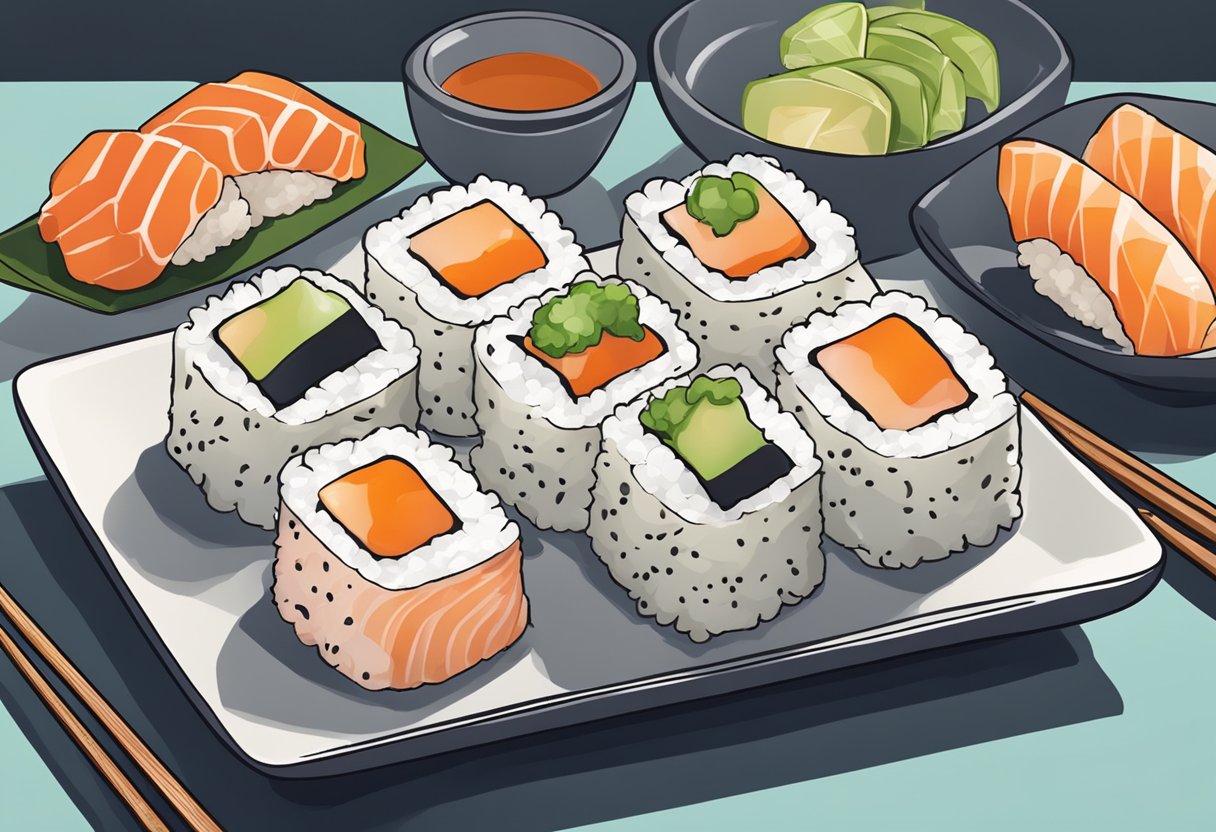
In conclusion, sushi can be keto-friendly if chosen carefully and consumed in moderation. Sashimi, which is raw fish without the rice, is a great option for those following a keto diet. Nigiri sushi, which is a slice of fish on top of a small ball of rice, can also be enjoyed in moderation. However, rolls that contain rice and other non-keto-friendly ingredients like tempura or sweet sauces should be avoided.
It’s important to note that the nutritional content of sushi can vary widely depending on the type of fish used, the preparation method, and the ingredients used in the roll. Therefore, it’s important to check the nutritional information before consuming sushi to ensure it fits into your daily macros.
Overall, sushi can be a healthy and delicious addition to a keto diet when chosen mindfully. By selecting sashimi or nigiri sushi and avoiding rolls with rice and non-keto-friendly ingredients, sushi can be enjoyed as a treat while still staying within the guidelines of a keto diet.






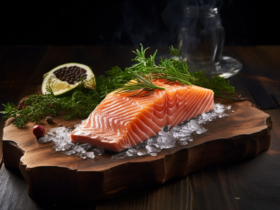

Leave a Reply